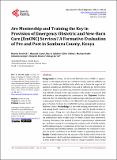Are Mentorship and Training the Key in Provision of Emergency Obstetric and New-Born Care (EmONC) Services? A Formative Evaluation of Pre and Post in Samburu County, Kenya
View/
Publication Date
2021-12-28Type
Article, Journalviews
downloads
Metadata
Show full item recordCitation
Fredrick, M., Diana, M., Jackline, K., Colleta, K., Ruth, M., George, G., Bonnie, M. and Jarim, O. (2021) Are Mentorship and Training the Key in Provision of Emergency Obstetric and New-Born Care (EmONC) Services? A Formative Evaluation of Pre and Post in Samburu County, Kenya. Open Journal of Clinical Diagnostics , 11, 100-111. https://doi.org/10.4236/ojcd.2021.114008
Abstract/
Background: In Kenya, the Maternal Mortality Ratio (MMR) is approximated to 362 maternal deaths per 100,000 live births while the stillbirth rate stands at 23 deaths per 100 live births which are far below the target of 147 maternal mortality per 100,000 live births and 12 stillbirths per 100 live births respectively. Progress in addressing preventable maternal and newborn deaths and stillbirths depend on the improvement of the quality of maternal, fetal and newborn care throughout the continuum of care. Objective: To determine the effect of mentorship and training in improving the provision of Basic Emergency Obstetric Newborn Care (BEmONC) and Comprehensive Emergency Obstetric Newborn Care (CeMONC) services among health workers in Samburu County. Methodology: A one-week training intervention was carried among health workers in level three, four and five health facilities by master trainers. Using two tools adopted from MEASURE Evaluation and a structured questionnaire, a total of 54 (before the intervention) and 64 (after the intervention) health workers from 29 health facilities were interviewed. Training effectiveness was assessed by means of questionnaires administered pre- and post-training, by correlating post-training results of health workers, and through participatory observations at the time of on-site supervisory visits, mentorship and monthly meetings. An assessment was conducted to measure the level of confidence of the health workers in performing their duties. Results: Central Samburu had the majority of the health workers both at the pre-intervention (44.4%) and post-intervention (51.6%), North Samburu had an extra health worker at post-test while no change in numbers was recorded in East Samburu. A majority of the health workers across the three sub-counties were 31 - 40 years old, with only 2 (3.8%) aged 51 years and above. Following the interventions, improvements in the practice of BEmONC services were seen across the three sub-counties. There was an increase, at post analysis, in the use of the partograph to monitor labour (from 52% to 98.1%) and managing severe infection in the newborn (from 40.4% to 60.3%). Performing CS improved from 17.3% to 31% and the same was also recorded in carrying out blood transfusions. On post-survey, health workers reported the least confidence in performing manual vacuum. Other BEmONC services including active management of 3rd stage labor, use of partograph, manual removal of the placenta, managing maternal sepsis and identifying danger signs in the newborn had a high rate of confidence. Conclusions: This study finds that structured mentorship is an effective strategy to build the capacity of health workers. However, there is a need for further research to monitor and evaluate if such programmes improve clinical outcomes in the long run.
Subject/
Kenya; Maternal Mortality Ratio (MMR); Basic Emergency Obstetric Newborn Care (BEmONC); Comprehensive Emergency Obstetric Newborn Care (CeMONC); MEASURE Evaluation; Central Samburu; Health Workers; Training; Mentorship
Further Details
Copyright © 2021 by author(s) and Scientific Research Publishing Inc. This work is licensed under the Creative Commons Attribution International License (CC BY 4.0). http://creativecommons.org/licenses/by/4.0/

